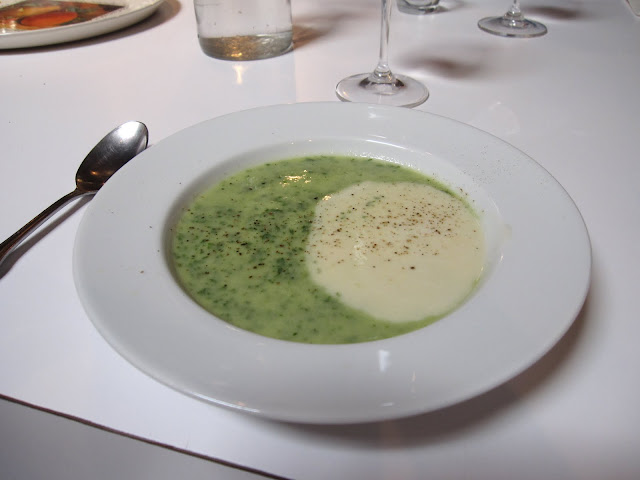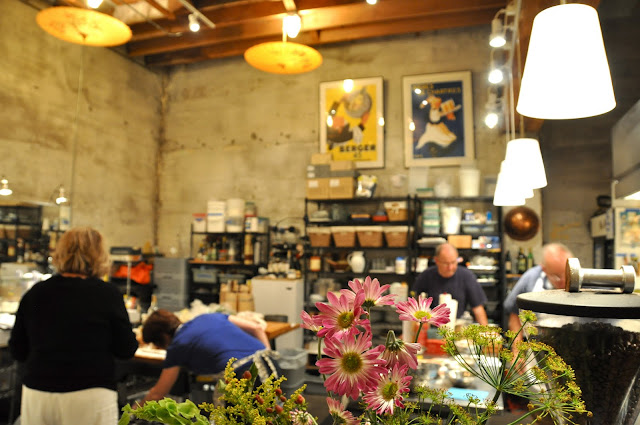How does one create a sense of place?
How does one give soul to what otherwise is simply a location?
One can learn quite a bit on this topic of "place" upon entering The Chefs Studio – the small one-room cooking school in SE Portland that acts as the canvas of Robert Reynolds. It's where this cookbook idea is taking shape. It's where I attended last winter and where I've returned to now.
 |
| Robert - Moving quickly, Smiling often |
Robert has most definitely created a place at The Chefs Studio. How is it so?
For me it is the fact that someone from the neighboring restaurant, Ken’s, often brings over loaves of bread for us, and that Robert routinely raids their kitchen for ingredients we are missing.
Last night: anchovies.
Last week: salad greens.
There is a symbiotic culinary community happening here.
For me it is Robert’s Tintin memorabilia lining the walls. That there are always fresh flowers.
It is that the chime on the door joyously marking the beginning of each lesson. So simple, so sweet, so resounding.
No windows line the walls, and the only natural light comes from two skylights on the very high ceiling. The resulting coziness draws you deep into the intimacy there, particularly on rainy Portland evenings where what you want most is a hot meal. You've arrived.
No windows line the walls, and the only natural light comes from two skylights on the very high ceiling. The resulting coziness draws you deep into the intimacy there, particularly on rainy Portland evenings where what you want most is a hot meal. You've arrived.
Then there is Thomas, Robert's large shadow-gray poodle who gives you a hearty greeting and watches over us quietly from his bed by the door as we cook. There is the baby blue French stove that requires its own lecture and lesson.
This is a place. And this place has a breathing, ebbing, delicious soul. It reflects the souls of those who created it.
The first time I met Robert was at a dinner party. He came over to where I was chopping chives and lovingly corrected my technique - "You don't want to give everyone indigestion do you?" he said. I liked him immediately. We became friends. He loved my cookbook idea. I wanted and needed to learn more than chive cutting to write a cookbook. And so here we are.
We are 5 students this session. Plus Robert. And often an assistant teacher - Courtney, Kristen, and Blake are the mainstays. I pause at times to wonder how so much talent can be held in one room. But then again... it is this room.
 |
| Blake and John last winter getting dinner organized |
We talk. We cook. We eat.
The way in which we go about these acts is deeply influenced by Robert’s belief that to learn to cook well is to learn to think about food differently. That is...
A dish is a construct. Understanding the construct of what you're making is the thing that turns food to art. It unleashes you from the recipe and moves you to creativity. Essence of Shoofly Pie - this idea in action
Each food has an essence and it brings that to any dish it enters. Understand its essence and your ability to work with it will be transformed. (My breakthrough on this point was with garlic. But that's another story.)
Each food has an essence and it brings that to any dish it enters. Understand its essence and your ability to work with it will be transformed. (My breakthrough on this point was with garlic. But that's another story.)
 |
| Reviewing the way the French see a meal. Intentional, slow, moving in an arc. |
Food is Soil. Food is Season. Food is Culture.
And Culture is People. In the Studio, this means French people, for in his heart Robert is truly French. His love of the French people he calls family there leaps out as he talks and writes. He was trained by Madeleine Kamman and Jospehine Araldo, two French gastronomic goddesses. Josephine in particular lives and breathes in this place as Robert instructs us, though she is long gone.
What Josephine used to sweetly say about sauce, or a mixing bowl, or the act of cleaning up.
How Josephine got engaged to be married. How Josephine changed Robert's life.
What Josephine used to sweetly say about sauce, or a mixing bowl, or the act of cleaning up.
How Josephine got engaged to be married. How Josephine changed Robert's life.
Each class we review our menu, and we divide up tasks. I usually have to fight the urge to jump at the dessert. I usually lose that fight and jump at the dessert.
Fig sorbet. Lemon tart. Tarte Tartin.
And then we cook. It is a whirlwind of movement - Demonstrations. Mistakes. Music. Epiphanies. The smells envelope us. The tasting spoons are plenty.
 |
| Polenta and dessert prep |
 |
| Watercress Gruyere soup |
Finally, we sit and eat the 4 courses we’ve prepared, inspecting texture, analyzing flavor profile, what we might change next time.
Stories of Josephine float.
Stories of our home experiments fly.
Stories of butter, olive oil, and cream bring us back to earth.
We clean thoroughly, and with a bit of leftover soup/duck/tart in hand, we depart, looking toward the next adventure in this place.
Bon Appétit Indeed.
For a taste of Robert's writing check out his blog. And also...
The Paley's Place Cookbook
From a Breton Garden
An interview at Reluctant Gourmet




No comments:
Post a Comment